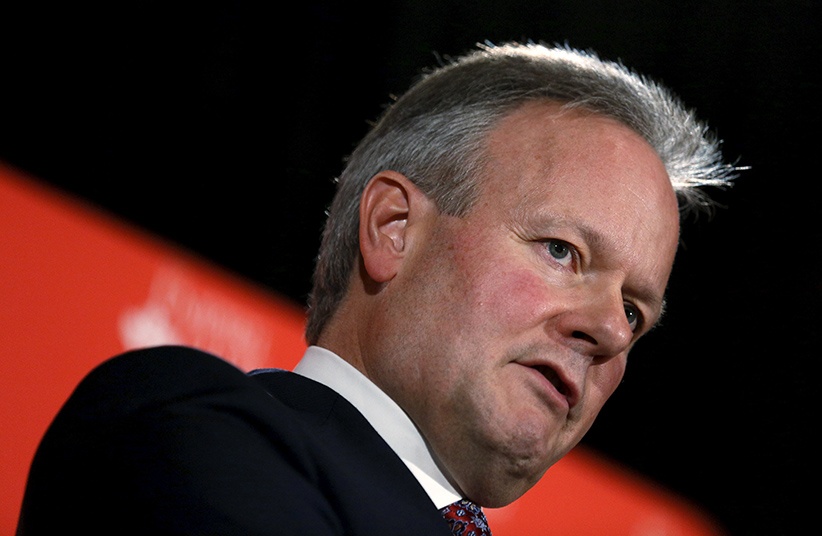Free money? Watch what you wish for.
Jason Kirby examines the true impact of Stephen Poloz’s surprise 2015 plan to cut the bank’s key overnight rate, one year ago this month
Share

During his time as governor of the Bank of Canada, Stephen Poloz has adopted many a metaphorical persona to explain the bank’s decisions to Canadians: a chef when comparing monetary policy to making spaghetti sauce, a dog-walker when analyzing exchange rates, a hockey-card trader when discussing the shifting value of oil. One year ago this month Poloz donned doctor’s scrubs, pulled out his scalpel and surprised almost everyone by cutting the bank’s key overnight rate by 25 basis points to 0.75 per cent, a move he later equated to performing life-saving surgery on the Canadian economy. Another cut of the same size followed a few months later.
By Poloz’s telling, lower interest rates saved the patient—a victim of the shocking collapse in global oil prices—from certain death. Again. For years now there has always seemed to be one more new threat lurking around the corner that warranted keeping rates lower for longer, and flooding the economy with what effectively was more free money in the form of cheap debt. It’s been the same story around the world. By some estimates the three largest central banks (in the U.S., Europe and China) have pushed US$7 trillion into the global economy to stimulate growth since the Great Recession. As the one-year anniversary of the Canadian economy’s supposedly near-death encounter approaches, and as Poloz ponders new tactics to drive rates even lower—with experimental measures like negative interest rates—it’s worth looking at what this free money has actually accomplished.
It’s impossible, of course, to know what would have happened if Poloz and his fellow central bankers hadn’t cut rates and maintained them at such low levels. But we have a fairly good idea of the things low rates have delivered—and robust, sustained and widespread growth is not among them.
Related: The 50 most important charts for the Canadian economy in 2016
One problem is that the longer rates stay low, the less effective they become. Consider Poloz’s two rate cuts last year. While Canada’s manufacturing sector enjoyed a bump in activity, and helped lift the economy from recession in early 2015, by December manufacturing activity was once again shrinking.
Interest rates have been low for a long time indeed. Over the last 15 years borrowing costs have steadily declined (save for a couple of relatively brief interruptions). Over that time the economy has stumbled from one debt-fuelled stock market, commodity or real estate bubble to the next.
The reason is simple: chronically cheap money distorts investment decisions and encourages excessive risk-taking. In the case of many publicly traded companies, the ones central bankers counted on to lift the economy’s fortunes, low rates enabled them to borrow vast sums and buy back their already inflated shares to juice stock prices—investments in factories, product and employee development be damned.
At the same time a generation has grown up with no concept of the five per cent interest rates of the early 2000s, let alone the punishing 15 to 20 per cent rates their parents and grandparents faced in the 1980s. So when the Bank of Canada cut rates last year, those consumers did exactly what was expected of them: they went house-hunting, shelled out for new wheels, and tapped their credit lines. From last January to October house prices in Toronto and Vancouver climbed at double-digit rates, while growth in household debt has exceeded gains in incomes by the widest margin in several years.
To its credit, the Trudeau government has taken some steps to try to cool overheating markets. In December, Finance Minister Bill Morneau tightened mortgage lending rules so that homebuyers requiring mortgage insurance and seeking loans exceeding $500,000 would require down payments of 10 per cent on any amount above that level. (The old five per cent down payment remains for mortgages below $500,000.) But the rules only apply to mortgages from federally regulated lenders, and the last few years have brought a boom in private mortgage lending, to which the new rules don’t apply. Besides, any prior efforts to cool the market by tightening lending rules have not made much of a difference, because for homebuyers, the fear of missing out on a hot housing market is a strong incentive to find alternative ways to borrow. Where there’s a will, there’s a lender willing to help them find a way.
Related: Stephen Poloz explains what Justin Trudeau is up against
To some extent, the Bank of Canada’s easy-money policy was hampered by the Harper government’s penny-pinching ways. Ottawa’s fiscal austerity measures worked at cross purposes with the Bank of Canada’s stimulative efforts (though provinces like Ontario and Quebec did their part to pick up the slack). With the Trudeau government swept to power on a platform of large-scale borrowing and deficit spending on transit and large-scale infrastructure—the types of things that may benefit the broader economy, and not just homebuyers—there is the potential for fiscal and monetary policy to work in tandem. A lot still depends on what happens with our largest trading partner, the U.S., where interest rates have finally begun to rise for the first time since 2006. However, the stimulative stars seem to be finally aligned.
We should watch what we wish for. Because that’s when the real complications of years of ultra-low rates will be felt. A return to growth would likely bring with it rising inflation, and that in turn would put pressure on the central bank to raise rates—delivering a painful shock to indebted households. If the we’re not careful, the patient may find itself right back on the operating table.